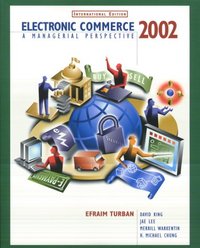買這商品的人也買了...
-
 $299Oracle SAP Administration (Paperback)
$299Oracle SAP Administration (Paperback) -
 計算機組織與設計--軟硬體界面第二版 (Computer Organization & Design, 2/e)
計算機組織與設計--軟硬體界面第二版 (Computer Organization & Design, 2/e)$680$537 -
 C++ 教學範本 (Beginning C++: The Complete Language )
C++ 教學範本 (Beginning C++: The Complete Language )$680$537 -
 Building Cisco Multilayer Switched Networks
Building Cisco Multilayer Switched Networks$2,270$2,157 -
 $399Building Scalable Cisco Networks
$399Building Scalable Cisco Networks -
 Cisco Voice Over Frame Relay, ATM, and IP (Hardcover)
Cisco Voice Over Frame Relay, ATM, and IP (Hardcover)$2,270$2,157 -
 Oracle 資料庫實作與管理
Oracle 資料庫實作與管理$420$332 -
 $199Oracle Essentials: Oracle9i, Oracle8i & Oracle8, 2/e (Paperback)
$199Oracle Essentials: Oracle9i, Oracle8i & Oracle8, 2/e (Paperback) -
 Thinking in Java 中文版 (Thinking in Java, 2/e)
Thinking in Java 中文版 (Thinking in Java, 2/e)$920$727 -
 Electronic Commerce 2002: A Managerial Perspective, 2/e (IE-Paperback)
Electronic Commerce 2002: A Managerial Perspective, 2/e (IE-Paperback)$820$199 -
 演算法導論 (Introduction to Algorithms, 2/e)
演算法導論 (Introduction to Algorithms, 2/e)$860$679 -
 內嵌式 Linux 系統--硬體、軟體與介面 (Embedded Linux: Hardware, Software, and Int
內嵌式 Linux 系統--硬體、軟體與介面 (Embedded Linux: Hardware, Software, and Int$450$383 -
 深入淺出 Enterprise JavaBeans (Mastering Enterprise JavaBeans, 2/e)
深入淺出 Enterprise JavaBeans (Mastering Enterprise JavaBeans, 2/e)$680$530 -
 C++ Builder 6 完全攻略
C++ Builder 6 完全攻略$690$587 -
 作業系統概念 (Operating System Concepts, 6/e Windows XP Update)
作業系統概念 (Operating System Concepts, 6/e Windows XP Update)$780$741 -
 Java 完美經典優質學習篇
Java 完美經典優質學習篇$750$638 -
 ASP.NET 程式設計徹底研究
ASP.NET 程式設計徹底研究$590$466 -
 Windows Server 2003 網路與 IIS 架站指南
Windows Server 2003 網路與 IIS 架站指南$680$537 -
 鳥哥的 Linux 私房菜-伺服器架設篇
鳥哥的 Linux 私房菜-伺服器架設篇$750$638 -
 Oracle PL/SQL 程式設計 (Oracle PL/SQL Programming, 3/e)
Oracle PL/SQL 程式設計 (Oracle PL/SQL Programming, 3/e)$1,200$948 -
 JSP 2.0 技術手冊
JSP 2.0 技術手冊$750$593 -
 MySQL 學習手札 (MySQL Tutorial)
MySQL 學習手札 (MySQL Tutorial)$390$332 -
 ASP.NET 徹底研究進階技巧─高階技巧與控制項實作
ASP.NET 徹底研究進階技巧─高階技巧與控制項實作$650$507 -
 ASP.NET MVC 2 開發實戰
ASP.NET MVC 2 開發實戰$590$466 -
 無瑕的程式碼 - 敏捷軟體開發技巧守則 (Clean Code: A Handbook of Agile Software Craftsmanship)
無瑕的程式碼 - 敏捷軟體開發技巧守則 (Clean Code: A Handbook of Agile Software Craftsmanship)$580$452
相關主題
商品描述
Any organization that uses the Oracle relational database management system (RDBMS) these days needs to use multiple databases. There are many reasons to use more than a single database in a distributed database system:
In a distributed database environment, data in two or more databases is accessible as if it were in a single database. Usually, the different databases are on different servers, which may be located at the same site or a continent away. Communication between the servers takes place via SQL*Net (for Oracle7) or Net8 (for Oracle8).
Distributed database environments offer a number of benefits over single- database systems, including:
This book describes how you can use multiple databases and the distributed features of Oracle to best advantage. It covers:
Table of contents:
Part I: The Distributed System
Part II: Replication
Part III: Appendixes
Appendix A: Built-in Packages for Distributed Systems Appendix B: Scripts
- Different databases may be associated with particular business functions, such as manufacturing or human resources.
- Databases may be aligned with geographical boundaries, such as a behemoth database at a headquarters site and smaller databases at regional offices.
- Two different databases may be required to access the same data in different ways, such as an order entry database whose transactions are aggregated and analyzed in a data warehouse.
- A busy Internet commerce site may create multiple copies of the same database to attain horizontal scalability.
- A copy of a production database may be created to serve as a development test bed.
In a distributed database environment, data in two or more databases is accessible as if it were in a single database. Usually, the different databases are on different servers, which may be located at the same site or a continent away. Communication between the servers takes place via SQL*Net (for Oracle7) or Net8 (for Oracle8).
Distributed database environments offer a number of benefits over single- database systems, including:
- Tunability
- Platform autonomy
- Fault tolerance
- Scalability
- Location transparency
- Site autonomy
This book describes how you can use multiple databases and the distributed features of Oracle to best advantage. It covers:
Table of contents:
Part I: The Distributed System
- Introduction to Distributed Database Systems
- SQL*Net and Net8
- Configuration and Administration
- Distributed Database Security
- Designing the Distributed System
- Oracle's Distributed System Implementation
- Sample Configurations 8. Engineering Considerations
Part II: Replication
- Oracle Replication Architecture
- Advanced Replication Option Installation
- Basic Replication
- Multi-Master Replication
- Updateable Snapshots
- Procedural Replication
- Conflict Avoidance and Resolution Techniques
Part III: Appendixes
Appendix A: Built-in Packages for Distributed Systems Appendix B: Scripts
商品描述(中文翻譯)
任何當前使用 Oracle 關聯式資料庫管理系統 (RDBMS) 的組織都需要使用多個資料庫。在分散式資料庫系統中使用多個資料庫有許多原因:
- 不同的資料庫可能與特定的業務功能相關聯,例如製造或人力資源。
- 資料庫可能與地理邊界對應,例如在總部位置有一個龐大的資料庫,而在區域辦公室有較小的資料庫。
- 可能需要兩個不同的資料庫以不同的方式訪問相同的數據,例如一個訂單輸入資料庫,其交易在數據倉庫中被聚合和分析。
- 繁忙的網路商務網站可能會創建多個相同資料庫的副本以實現水平擴展性。
- 可能會創建一個生產資料庫的副本作為開發測試環境。
在分散式資料庫環境中,兩個或更多資料庫中的數據可以像在單一資料庫中一樣訪問。通常,不同的資料庫位於不同的伺服器上,這些伺服器可能位於同一地點或相隔一個大陸。伺服器之間的通信通過 SQL*Net(適用於 Oracle7)或 Net8(適用於 Oracle8)進行。
分散式資料庫環境相較於單一資料庫系統提供了多項優勢,包括:
- 可調整性
- 平台自主性
- 容錯性
- 可擴展性
- 位置透明性
- 站點自主性
本書描述了如何利用多個資料庫和 Oracle 的分散式功能來獲得最佳效益。內容涵蓋:
目錄:
第一部分:分散式系統
- 分散式資料庫系統簡介
- SQL*Net 和 Net8
- 配置與管理
- 分散式資料庫安全性
- 設計分散式系統
- Oracle 的分散式系統實作
- 範例配置
- 工程考量
第二部分:複製
- Oracle 複製架構
- 進階複製選項安裝
- 基本複製
- 多主複製
- 可更新快照
- 程序複製
- 衝突避免與解決技術
第三部分:附錄
附錄 A:分散式系統的內建套件
附錄 B:腳本










